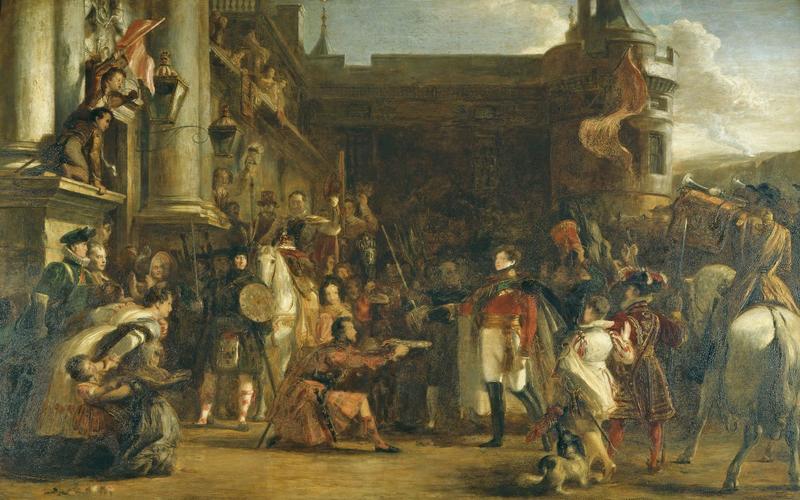The Entrance of George IV at Holyroodhouse 1822-30
Oil on mahogany panel | 126.0 cm x 198.1 cm x 16 mm (support, canvas/panel/stretcher external) | RCIN 401187

Sir David Wilkie (1785-1841)
The Entrance of George IV at Holyroodhouse 1822-30
-
David Wilkie was one of the most successful painters of the Regency period and was greatly encouraged by the Regent. Born in Fife, trained in Edinburgh, Wilkie settled in London in 1805 and began regularly exhibiting at the Royal Academy small scale scenes of everyday life. At this time Dutch and Flemish old master paintings were hugely popular and expensive, as is demonstrated by the works collected at this time by George IV. Wilkie began his career consciously emulating the low-life scenes of Teniers and Ostade, but by the 1820s he had begun to set his sights rather higher, taking Rubens as his model, in particular the fluid and painterly character of Rubens’s oil sketches. Wilkie’s royal career involved succeeding Raeburn as Limner to the King in Scotland in 1823 and Lawrence as Principal Painter in Ordinary to the King in 1830; he remained in these positions until his death, although Queen Victoria disliked his work.
George IV succeeded his father as King in 1820 and in August 1822 was the first reigning monarch to visit Scotland since Charles I. George IV arrived at Holyroodhouse in the afternoon of 15 August 1822. This is Wilkie's painted record of that event, which he also described as an eye-witness: ‘I saw the King alight; he had not much colour, but upon the whole was looking well. He was dressed in the field marshal’s uniform, with a green ribbon of the Order of the Thistle. He was received by the Dukes of Hamilton and Montrose’.
The event took place in front of the Palace of Holyroodhouse where the keys to the Palace were presented to the King by the hereditary Keeper, Alexander, 10th Duke of Hamilton (1767-1852). To the left of the King the figure of the Lord Chamberlain, James Graham, 3rd Duke of Montrose, points towards the entrance of the palace. This operatic scene has many other ceremonial principals who are supported by a chorus of enthusiastic spectators clambering over every part of the palace to catch a view of the King.
It was not until 1823 that Wilkie seriously turned his mind to this commission and it occupied him intermittently until about 1830. The most obvious source of inspiration is Rubens's famous Marie de' Medici cycle (Louvre), the sort of royal imagery which might have inspired George IV's staging of the event as well as Wilkie's depiction of it. Numerous sketches still exist, several of which are in the Royal Collection (see 409055). Wilkie’s diary also records the sittings he had in both London and Edinburgh with the various figures in the painting, including those with Sir Walter Scott, who organised the whole visit to Scotland and who in the finished work is dressed ‘in the character of historian or bard’.Provenance
Painted for George IV for 1600 guineas; added to the Carlton House inventory dated 1819 (no 634); in the Picture Gallery at Buckingham Palace in 1841 (no 69)
-
Creator(s)
Acquirer(s)
-
Medium and techniques
Oil on mahogany panel
Measurements
126.0 cm x 198.1 cm x 16 mm (support, canvas/panel/stretcher external)
174.1 x 242.2 x 16.5 cm (frame, external)
Category
Object type(s)
Other number(s)
Alternative title(s)
The entrance of King George IV at Holyroodhouse








